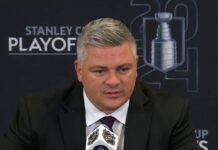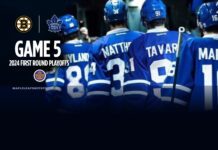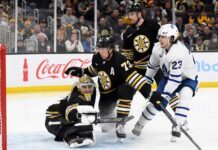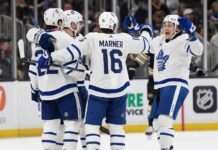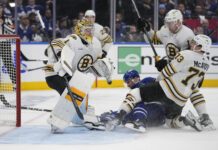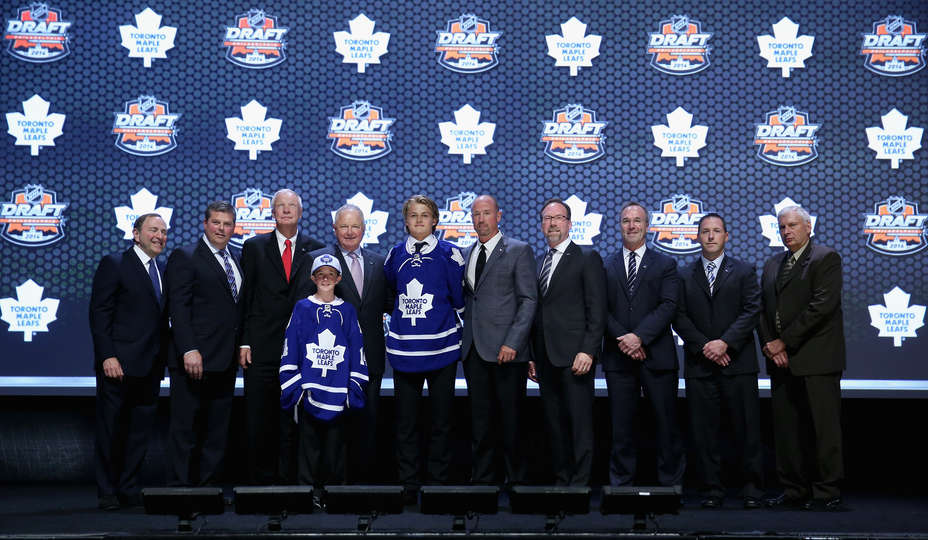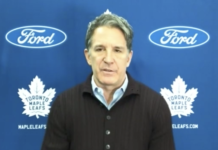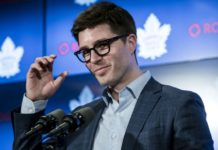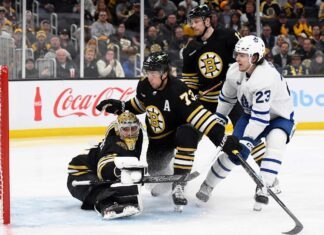MLHS’ in-depth off-season interview with Toronto Maple Leafs Director of Amateur Scouting Dave Morrison—conducted by Anthony Petrielli—will be split into three parts and rolled out over the next few days. Part One touches on the summer prospect development camp, some draft philosophy questions, and the Maple Leafs’ 2014 draft class.
Anthony Petrielli: How was the development camp?
Dave Morrison: Good. I was really happy with the group. I like the mix that we have going right now. We were able to add, as you know, quite a bit more skill over the last few years. We’ve got a nice mix of prospects.
AP: Yeah, I was looking at the stable of prospects from when Brian Burke first got here, and I think it’s safe to say that it was pretty bare. In saying that, was there sort of a mandate to maybe draft safer picks to build some sort of foundation?
DM: No, not really. I think at that time we were kind of going for being a bigger, stronger, tougher team, so if you look at some of those picks in the first couple of years we tried to do that. I think sometimes those players take a little longer to develop because they are bigger and brawnier, and you have to be patient. They’re not those flashy kind of players so sometimes they don’t get the notoriety of a flashier, skill player. I think that sort of happened there. I think the previous draft to that was the Cliff Fletcher draft with all the defensemen. That was sort of that top 5-group with Stamkos going first.
AP: Yeah, it went Stamkos, Doughty, Bogosian, Pietrangelo, and then Schenn.
DM: I think if you look at that order, that was probably the way it was going to go and if you wanted one of those kids you had to move up into it. Which is what we did, and Luke just happened to be more of a stay at home, big, strong type of guy. I think it’s one of those things where sometimes you’re trying to make your team a little different in different ways so you do what your philosophy dictates at that time.
AP: When would you say the philosophy sort of flipped from drafting those big, strong, tough guys?
DM: Initially we were trying to get bigger and stronger, and I think you realize you do have to have skill and it was a gradual process. I think we were always looking for skill too… I don’t think you just go out and say we’re going to get big and tough in one draft. It doesn’t work that way. You have to have talented players that can play the game, so even though we were trying to get bigger and tougher, that’s not the case with every pick. And then I think gradually we had a number of bigger, stronger, powerful type forwards, so we just looked at it and said we need to get a little more skill. You can see gradually over time that we started to pluck a little more skill. Connor Brown was a really small, skilled player three years ago, you could see we were going after skill. A kid like Tony Cameranesi is another smaller, speedy player. The draft is just so hard to predict, but you really rank them as you feel their NHL potential dictates. So, when it’s your turn you take that best available player and sometimes your focus might be on bigger, stronger players, or smaller, skill players, but it’s still NHL potential dictates where they land on your list.
AP: Did that mandate to switch come from Burke?
DM: It’s kind of an organizational thing, Dave Nonis and that group, Shanahan as well. It’s an ongoing process that you talk about during the year. It’s not like all of a sudden you decide one day it’s time to get more skill. You don’t necessarily do that. It’s a thing you talk about constantly. You need to have skill in your line-up, you need to have toughness in your line-up. It’s that mix and that combination you look for. But you can’t just say we want this type of player because if you go out of your way to get a certain player you will more than likely miss out on something else. At the end of the day, even though the focus might have been on a certain area at certain times, we always tried to get the player with the most NHL potential. It sounds simplistic, but that’s basically what it is.
AP: Shanahan came in late in the process this year, did he really have an influence on this draft?
DM: You know what, he was involved. He wanted to learn how the whole process works. Between he and Dave Nonis, they were both involved. They’re always involved to a certain extent. I go back to the course of the year, you’re talking about who’s available, who isn’t available. What type of players this year, what’s the draft like the year after, because ultimately when the deals are made a lot of these picks are one or two years out. In terms of Brendan coming in, he had a lot to do in a short period of time but he was certainly involved and wanted to know how the process worked, and what the kids were like, and what types of players they were. Dave Nonis has always been involved as well. It’s a fluid process between us. It has to be. They have to know what’s going on, and I do to a certain extent as well so I can be prepared too.
AP: I don’t know if you know this, but they showed your table at the draft and it looked like you, Shanahan, and Nonis were arguing right before you drafted Nylander.
DM: Yeah, it wasn’t an argument, it was more a discussion about the pick because there was different scenarios that could have happened at that time so I was sort of stating my case on where we stood as a staff. There’s always different scenarios that can happen, trades and things, so there was a discussion about, “okay this is what we can do, can’t do.” So I basically laid out how we felt as a staff. I guess it was a normal, pre-pick discussion because a lot of those things happen very quickly. When you have opportunities to do different things with your pick, sometimes it can be an ongoing discussion for that whole day leading up to it, and then all of a sudden it gets down to crunch time and it’s like “okay, this is what we have to do; do we want to do this or not, and is this your guy?” All those types of discussions happen. I guess, at the end of the day, it came out like we wanted it to come out, so that’s good.
AP: Yeah, I think the Haydn Fleury pick kind of threw it off a little bit.
DM: It’s funny, we had a mock scenario with the first six picks right, and then we were off on the seventh. He’s a solid player too, though. But we really like Willie Nylander, so we’re happy with how it turned out.
AP: Is he actually 5’9?
DM: Now he’s actually 5’11+. I can’t say for certain, but I know he’s minimum 5’11, maybe 5’11 and a half. And he might still be growing. I’m pretty certain he’s 183 pounds right now. He’s a lot bigger than people keep saying he is. If you saw him on the stage, he’s almost the same height as me and I’m 6’1.
AP: That’s funny because I was thinking about that comparison between he and you on the stage.
DM: It’s funny you say that because when I got back to the table, the guys at the table were going “he’s almost as big as you.” And I said, I know, I don’t know why everyone thinks he’s such a small kid. He’s not a small kid.
AP: He looks like a little kid, I think that’s the thing, right?
DM: Yeah. That is more of the issue I think. He’s so young looking in the face and I think that throws it off.
AP: Do you consider him a C or W?
DM: Well, I think we’ll let time tell. He can play either which is nice to have. Where he’ll be most effective I’m not sure, he’s the type of kid that controls the play, he protects the puck well and controls it very well. Whether he plays at wing or center he’s going to play that same type of game, it’s more a case of the defensive end of the game and what he as a pro will be able to handle. Whether he’s e able to play defense and still bring the offense, and still play that puck controlling type game, or if he’ll be better suited doing that from the wing position. I think it’s just a case of how he develops and what he’s better suited at. AP: He can play in the AHL this year, correct?
DM: Yes, he can.
AP: Is there anyway where you’d look at it and say, ‘it’d be nice to develop him as a C,’ and groom him as one down there? Maybe it takes a little longer, but hopefully the end result is you get a top flight C.
DM: I think you have to kind of wait and see where he’s at in his development. One thing we really found out about Willie in his lead up to the draft is that he’s a really diligent, hardworking, character kid. So you know he’s doing all the right things right now preparing himself. How much bigger and stronger can he get by September? Well, that’s hard to tell because physiologically everyone is different but he certainly puts the work in and we know now he’s not as small as everyone thinks he is. So we really have to wait and see where he fits in at that time and then I think the decision will be made.
AP: I thought for sure you guys would want to, maybe not force him, but maybe try to groom to be a top flight C.
DM: Ideally, you’d love it if he became your top line center. That’d be the optimal situation. But I think at some point you have to let his development take its course right. I think if we can we will, but it’s just hard at this point because he’s such a young guy, so you want to let the development take its natural course and where he fits in. If it’s down the middle and he becomes our top line center at some point, that’s fantastic. If it’s on the wing and he becomes a top line winger, that’s fantastic, too.
AP: I was watching some of the videos from development camp and Nylander was just doing ridiculous stuff. He was on a totally different level than some of the guys there.
DM: He’s got a great shot, and he sees the ice, and it’s effortless. He makes it look easy at times. And he’s a good kid who is doing all the right things. He controls the puck so well. He has that ability to hang onto the puck and he can do it in tight situations. That’s what the NHL is all about — there’s so much pressure, and there’s so much stick on puck with these big defencemen with these long reaches, you have to have the ability to quickly stick handle and change your body position to buy yourself time to make a play. He’s got those abilities.
AP: I don’t like to compare a kid to Kessel, but he kind of looks like him with that hunched-over, powerful low base when he’s skating.
DM: I’d love to see those two guys play together in training camp. I’d love to see that dynamic, or him with JvR. I’m excited to see him play with these guys. I don’t know if he’s going to be ready to play in the NHL right now, because it’s a lot to ask of a young guy. I’m just excited to see him play with better players, because he has that ability. That’s the exciting part.
AP: A lot of people are excited. Hopefully he’s the real deal.
DM: I really like our Russian kid, too [Rinat Valiev]. He’s really a player for today’s NHL. He’s almost 6’3. A lot of people list him at around 6’1’, 190, but he’s six-foot-two and a half right now.
AP: That pick kind of surprised a lot of people, him being a year older, and he didn’t have unbelievable offensive numbers.
DM: He’s a big kid. Actually, Virtanen’s shoulder injury was because of a fight with our guy. YouTube it and check it out. But he’s a fantastic puck mover. He’s got that ability to make plays. People say that often about Stuart Percy and I think we’re starting to see that with Stuart; his puck movement is exceptional. I don’t think he’s quite at Stuart’s level, but he’s got those abilities to make those little plays down low and open the ice up.
AP: Did you take pause because he’s a year older? How hard is that to account for?
DM: He had a knee injury and he had kind of a screwy year the season before. There was a lot of misinformation about him and that’s why he went through the draft. He was projected to be a fairly high pick last year, and there was a lot of sort of weird stuff out there about him, except it wasn’t really that weird if you knew the story. I think that misinformation and the fact that he was Russian and went back home scared everyone off. He couldn’t get back here quick enough to play in the CHL; he literally got off the plane and played that night, that’s how badly he wanted to play. He’s a good kid and we’re happy we got him. I’m very hopeful with him because he’s a really talented player.
AP: You’ve talked before about knowing the draft board, where players are going to go as the years go on. Was there a feeling with Valiev that you couldn’t wait on him?
DM: We just felt, at that point, we had to take him. We really liked him as a player and our guys were raving about him in the first half of the year. We got to the point where we said, “let’s not screw around on this guy and just take him.” We had him rated pretty high on our list. We just followed our list, actually. We didn’t hesitate. Sometimes you try to overthink it because he’s been through the draft and you start to think, “why is that, why don’t we wait until the next round,” and then someone takes him. Why do that? Just believe in what you see and all the information you gathered which explained his year and why he didn’t get drafted the year before. Let’s just take him. We saw what we saw, so let’s take him. He’s grown a lot. We’re happy. He looked good at the development camp last week.
AP: Did anyone else pleasantly surprise you at camp last week?
DM: There were a couple of kids. Dakota Joshua — I was very pleasantly surprised that he didn’t have a problem with the pace. You never know how a first year player at the development camp is going to integrate himself in terms of the drills. I was very pleasantly surprised that he didn’t have any issues with the pace or the physicality. I thought that was very good. Pierre Engvall is another kid who really opened my eyes. Pierre, as a talent, as a long term guy, it might take him a while, but he’s a lot further ahead than I thought. He can really skate for a big man.
AP: He’s huge.
DM: He’s 6’4 and he can really skate. I was really pleased with his competitiveness. I can’t say I was disappointed with anyone, really. I thought some of the returnees looked very good. The things I was looking for probably happened with most kids. Maybe some more consistently than others, but all of them showed some of the things I had been looking for going in there. AP: How about Tony Cameranesi? He had a bit of a down year, points wise.
DM: It’s that 2nd year at school, and maybe sometimes the puck just doesn’t drop for you. I expect Tony to have a bounce back year. He’s got a real high competitive instinct and he’s a real character kid that way, so I’d expect things will change for him this year.
AP: That one caught me by surprise. He had a really good rookie season there.
DM: He had a good year in Waterloo the year before, and he went into Duluth and had a good rookie season there. I don’t know if it was a sophomore jinx or whatever they call it, or maybe the puck just didn’t bounce for him, but I honestly expect that to change. He’s too competitive for it not to.
AP: Last year you told me the GM usually comes in after you’ve identified the pick, just to get a feel for the guy.
DM: Yes. They know who we’ve targeted as a 1-2-3 type thing. And typically they are in the interviews and get to meet the kids.
AP: So that would be the U18s for Nonis, I’m guessing?
DM: Prior to the U18 there would have been a group of kids there. The problem this year was that our draft pick changed drastically in the last six weeks. So, the group we thought we were looking at changed a lot in the last six weeks, therefore it was really hard. I was telling them, “now we’re looking at this group,” and, “now we’re looking at this group.” Fortunately, Dave was able to come to the U18 and see a lot of the kids I was talking about. And others went far in the playoffs so we could catch up with them. He was able to watch most of the kids which was great, especially when you’re drafting in a higher position like 8. You want to have the confidence of the GM behind you. It was a little trickier the way things changed, but we were able to pull it off. And then, of course, with the interviews Dave got involved and Brendan became involved as well. It was a good process we went through.
AP: How difficult was it going from thinking you’re drafting around 20, to top 10?
DM: It’s not optimal for a number of obvious reasons. You adjust and you do what you have to do though. It’s just the travel thing, because you’re scheduling and traveling changes drastically so you’re doing a lot of scrambling that way. Fortunately, sometimes the U18 tournament worked out as a scouting tool really well when all the pieces falls into place and all the players will be there. That’s a great tournament, but you want to see the players play on their clubs teams. It’s imperative that you see them there, and it’s part of their scouting resume.
AP: You guys have drafted a few players after big U18 tourneys – D’Amigo, now Nylander. Biggs scored a big goal in that tourney.
DM: It’s helped I think in some cases, but I don’t think you want to rely totally on the U18 tournament. It’s certainly a piece of that pie and you can’t ignore it, but you don’t want to put all the weight on it. In Jerry’s case he had a really big year. In Biggs’ case he showed us a lot of toughness in those USHL games they play there in that schedule. It’s worked out that way, but it’s always just a piece of the pie.
Click here to read Part 2 of this interview with Dave Morrison
Click here to read Part 3 of this interview with Dave Morrison


